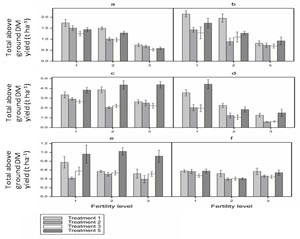Field work was started in the Cropping season of 2013 from May to November 2013. Two field trials have been conducted as follows and preliminary data analysis done: 1) Effect of intercropping patterns on biological nitrogen fixation (BNF) and crop productivity and 2) Effect of cowpea-maize relay intercropping on biological nitrogen fixation and crop productivity across fields of different soil fertility levels in northern Guinea and Sudan savanna agroecological zones of Ghana. Figure 1 shows preliminary results of the intercropping patterns on crop productivity. A rapid survey of farms (120 in farms total) has been conducted in the two trial villages in the Guinea and Sudan agroecological zones and a farm typology developed. A detailed farming system characterisation involving three farms each from the five farm types identified (30 farms in total) has also been completed. The preliminary analysis and results will be out soon as possible.
 |
Fig. 1 Total above ground dry matter yield (shoots + pods) for spatial plant arrangements of cowpea, soyabean and groundnut at three fertility levels and two agroecological zones. Total dry matter yield cowpea, soyabean and groundnut in AEZ 1 are respectively shown by figures a, c and e while b, d and f are for AEZ 2. Treatment 1 – within-row intercropping of maize and legume, treatments 2 and 3 – one row maize, one row legume as well as two rows maize and two rows legume in distinct row intercropping, treatment 5 – sole legume. |
Michael Kermah, Ghana, PhD student at Wageningen Unversity

